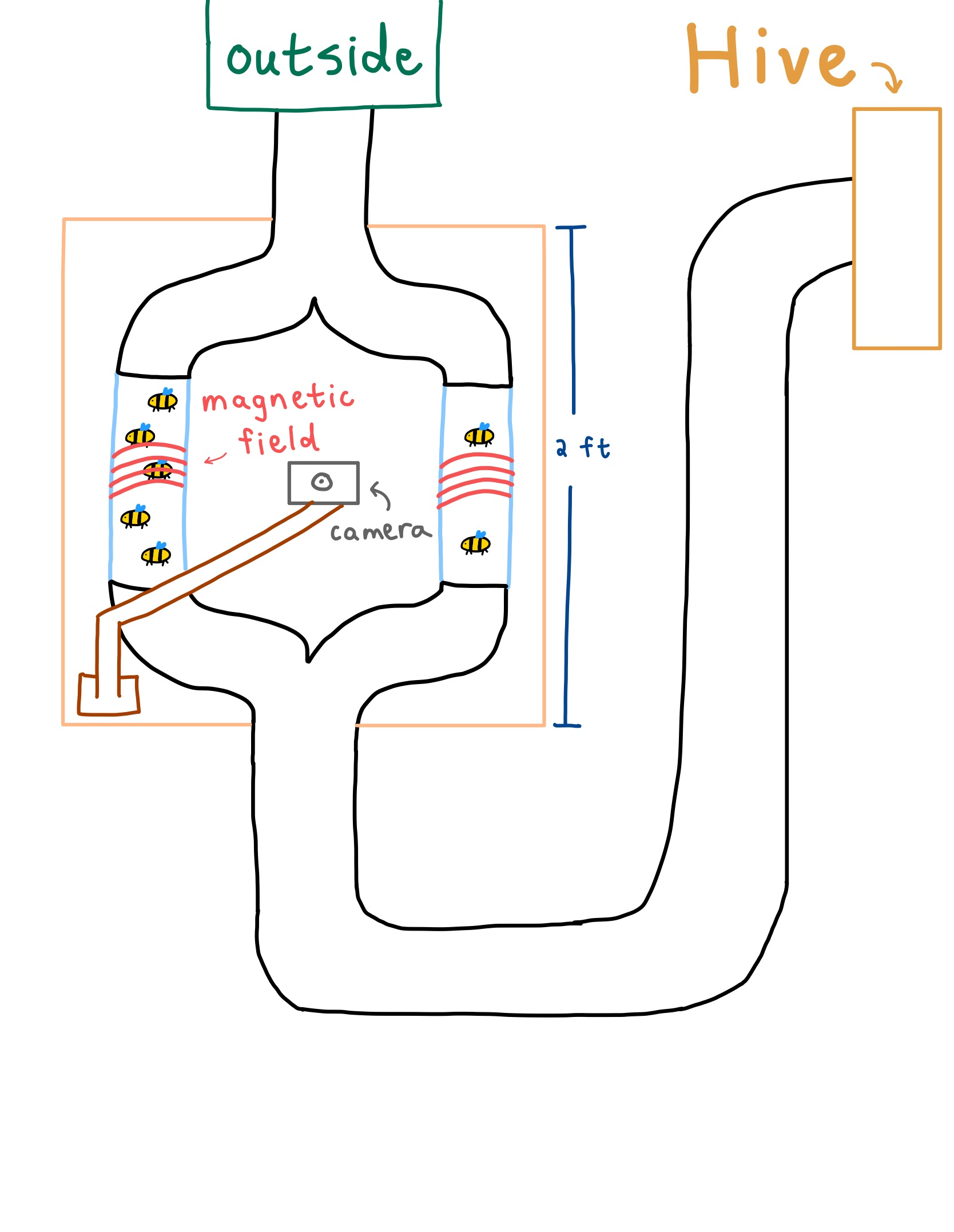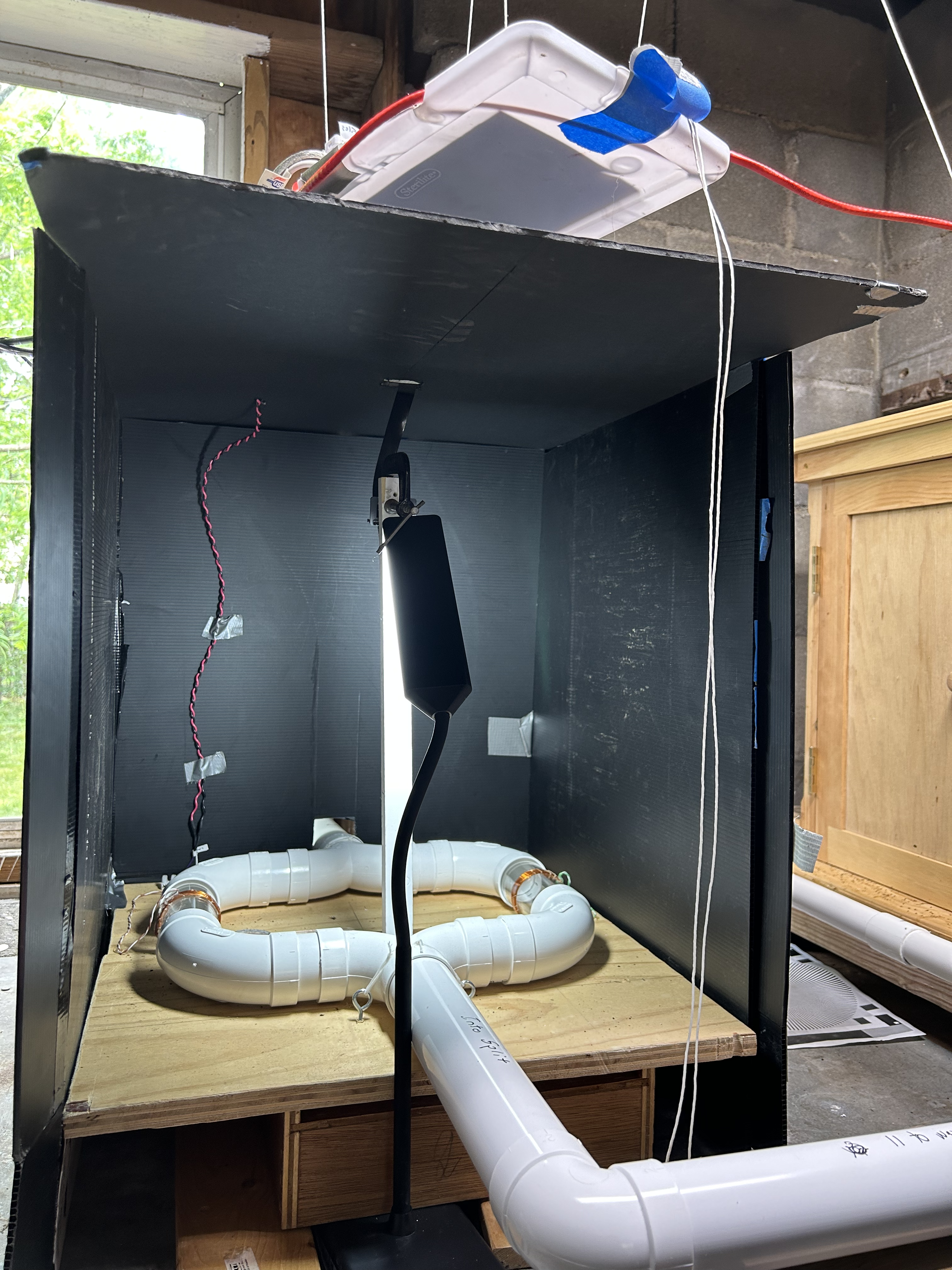| Version 76 (modified by , 2 years ago) ( diff ) |
|---|
Hive Monitoring
Advisors: Richard Howard, Richard Martin
Group Members: Tate Sparks, Shrinidhi Kesavan, Sarah Benedicto, Evan Kohut, Andrew Martin, Benjamin Yu, Sonia Malhotra
Overview
This study seeks to evaluate how bees are impacted by electromagnetic radio frequency (RF) waves emitted by humans. Similarly to how the lead epidemic has affected humans, radio frequency could prove to have an adverse effect on bee mortality.
Setup
Hive Camera
| A wide-angle camera and 4 IR lights are sealed inside a hive frame. A Raspberry Pi takes video and rectifies the fisheye image distortion. |
Progress
Week 1
Project Goal: The project's objective is to assess electromagnetic radio frequency (RF) impact on bees, particularly bee mortality, inspired by the lead epidemic's significance. It aims to examine how human-emitted RF affects bee populations and ecosystems.
Apparatus Mockup: Creating an apparatus in which the bees would come through from the tubes. The raspberry pi would be placed directly above the apparatus and the current would run through the apparatus.
Machine Learning Analysis: In the process of using pytorch libraries to test the machine learning scripts.
Week 2
Experiment Design:
Apparatus Construction: Modeled and figured out the correct sizing of it. The correct dimensions were found in order to cut and build the base. The glass tubes were cleaned and fixed. Lastly, a camera mount was established.
Raspberry Pi: ILAB was starting to get set up as well as running the machine learning scripts. Raspberry Pi Pinout was studied and code was written on it to control different states of the magnetic field.
Week 3
Data Collection: Videos of the bees were collected using the Raspberry Pi. The motion of the bees was observed depending on the different magnetic states. Machine learning would be used to analyze these videos.
Eliminating Extraneous Sources:
Week 4
Control Data: There was an expected 50% accuracy. It was also determined that there could be an issue with the distribution of the data. A spreadsheet was created to amend this issue by manually verifying states.
Log File Formatting: Created a spreadsheet to manually verify the states in the video
Fisheye Camera:
Week 5
Camera Calibration: The CV camera calibration library was opened. The camera needed to stop being distorted while being at a wide field view.
Machine Learning: The neural network was being trained to detect behavioral responses from the bees and the magnetic field. PyTorch libraries were utilized to run the machine learning scripts. Accuracy indicates how well the neural network classified the videos.
Week 6
Alternating Current Circuits: Created a program to run an alternating current. Attached new set of wires on the beehive to the breadboard to run the alternating current.
Camera Distortion: Began working on the deployment of the camera to the hive. Enclosed the camera with 2 IR lights in a hive frame. Sealed the frame with plastic poster board and aluminum tape. Doing so prevents the bees from chewing through to the camera.
Frame Dataset Corrections: Encountered issues with the video frames when creating the dataset.
Week 7
Accomplishments:Fixed the issues with the cropping in the video. Manually created datasets to run. Soldered wires to the resistors, wrapped wire around the glass tubes in the bee apparatus and connected the soldered wires to the Raspberry pi. Ran the circuit and collected data on bee motion with the AC current.
Camera: Two more IR lights are added in parallel for more even light distribution. The video capture code and undistortion code were combined. Power over ethernet was used as well.
Week 8
AC Circuit: Wrote program for an AC current, soldered the wires, resistors and capacitors. Wrapped the coil around the glass tube and attached it to the circuit board.
Week 9
Manual: In the process of creating a manual with instructions on how to operate the software.
Machine Learning: Generated expected accuracies for control data and generated high accuracies from data due to strong temporal correlation of the bees daily routine.
Software Debugged several issues with the existing software
Presentations
Week 1 https://docs.google.com/presentation/d/1MtKp_Q4kYj8rK5n1t4eCN10S3px53kY4lWW0k9Y2XSs/edit?usp=sharing
Week 2 https://docs.google.com/presentation/d/1ADvK4neFgE9My_yHJRX4hd7cKdQ70z3zusmd4PjSqkE/edit?usp=sharing
Week 3 https://docs.google.com/presentation/d/1Gh0W6tGCZ73KXImxl8CZYhpTA0nsuiyrOs0CsUNcRbU/edit?usp=sharing
Week 4 https://docs.google.com/presentation/d/1pCnK6VBakeFyNgBYtZI9LUvJrwMotd29TzDQ_zN5YRw/edit?usp=sharing
Midway Progress
https://docs.google.com/presentation/d/1BGfHoxGJ2W533OdZRhyn6lgF7OyR_DEVRs87jQCrT-Y/edit?usp=sharing
Week 6
https://docs.google.com/presentation/d/1uop2ytlSdMh5aFQvZgZPGiPWpo7b0tTZ4oaqu9TswJc/edit?usp=sharing
Week 7
https://docs.google.com/presentation/d/1k87TEy9SG5kleGvpUR2P4fqSRZFa3vHKRRMU991VSjY/edit?usp=sharing
Week 9
https://docs.google.com/presentation/d/1zJmH06sIY6u5Fpm4AA8TGh8lVHojb4kt9Rd9DZil3FI/edit#slide=id.p
Attachments (6)
- experiment diagram.png (672.8 KB ) - added by 2 years ago.
- apparatus box.png (14.1 MB ) - added by 2 years ago.
-
7-31.mp4
(10.9 MB
) - added by 2 years ago.
Video from inside the hive
- Screenshot 2023-08-09 at 11.25.03 AM.png (66.1 KB ) - added by 2 years ago.
-
Unknown
(8.4 KB
) - added by 2 years ago.
hive cam
- Hive Monitoring Final Poster.pptx.png (2.0 MB ) - added by 2 years ago.


